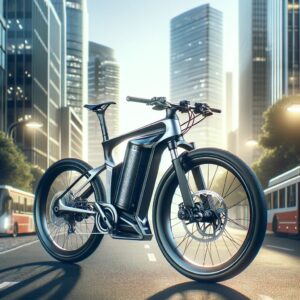Introduction
E-Bikes have gained popularity in recent years and offer an eco-friendly alternative to traditional means of transportation. A crucial component of any e-bike is the battery, which requires special care to maintain its performance and lifespan. In this blog post, we will focus on an important aspect of battery care: Why you should neither fully discharge nor fully charge your battery.
Why is Battery Care Important?
The battery is the heart of your e-bike. Without a well-functioning battery, the range is limited, and the performance of the e-bike is compromised. Therefore, it’s important to properly care for the battery to extend its lifespan and achieve the best possible performance.
The Myth of Full Discharge and Charge
Many people believe it’s best to fully discharge a battery and then fully recharge it. This myth comes from the era of Nickel-Cadmium batteries, which had a “memory effect.” Modern Lithium-Ion batteries, used in most e-bikes, do not suffer from this effect.
Why You Should Not Fully Discharge Your Battery
Fully discharging a Lithium-Ion battery can damage the cells and shorten the battery’s lifespan. It’s better to discharge the battery to about 20-30% of its capacity before recharging it.
Why You Should Not Fully Charge Your Battery
Fully charging a battery can also be harmful. It’s advisable to charge the battery only up to about 80-90% of its capacity. This prevents the battery from overheating and shortening its lifespan.
Conclusion
Proper battery care is crucial for the performance and lifespan of your e-bike. By neither fully discharging nor fully charging the battery, you can significantly extend the battery’s lifespan. Follow these tips, and your e-bike will serve you well for many years.
Wie Sie die Lebensdauer Ihres E-Bike-Akkus verlängern – Tipps zur Akku-Pflege
Einleitung
E-Bikes haben in den letzten Jahren an Popularität gewonnen und bieten eine umweltfreundliche Alternative zu herkömmlichen Verkehrsmitteln. Ein wesentlicher Bestandteil eines jeden E-Bikes ist der Akku, der spezielle Pflege erfordert, um seine Leistung und Lebensdauer zu erhalten. In diesem Blog-Beitrag werden wir uns auf einen wichtigen Aspekt der Akku-Pflege konzentrieren: Warum Sie Ihren Akku weder vollständig entladen noch vollständig aufladen sollten.
Warum ist Akku-Pflege wichtig?
Der Akku ist das Herzstück Ihres E-Bikes. Ohne einen gut funktionierenden Akku ist die Reichweite eingeschränkt und die Leistung des E-Bikes wird beeinträchtigt. Daher ist es wichtig, den Akku richtig zu pflegen, um seine Lebensdauer zu verlängern und die bestmögliche Leistung zu erzielen.
Der Mythos der vollständigen Entladung und Aufladung
Viele Menschen glauben, dass es am besten ist, einen Akku vollständig zu entladen und dann wieder vollständig aufzuladen. Dieser Mythos stammt aus der Zeit der Nickel-Cadmium-Akkus, die ein “Memory-Effekt” hatten. Moderne Lithium-Ionen-Akkus, wie sie in den meisten E-Bikes verwendet werden, leiden jedoch nicht unter diesem Effekt.
Warum Sie Ihren Akku nicht vollständig entladen sollten
Das vollständige Entladen eines Lithium-Ionen-Akkus kann die Zellen schädigen und die Lebensdauer des Akkus verkürzen. Es ist besser, den Akku auf etwa 20-30% seiner Kapazität zu entladen, bevor Sie ihn wieder aufladen.
Warum Sie Ihren Akku nicht vollständig aufladen sollten
Das vollständige Aufladen eines Akkus kann ebenfalls schädlich sein. Es ist empfehlenswert, den Akku nur bis etwa 80-90% seiner Kapazität aufzuladen. Dies verhindert, dass der Akku überhitzt und seine Lebensdauer verkürzt wird.
Fazit
Die richtige Pflege des Akkus ist entscheidend für die Leistung und Lebensdauer Ihres E-Bikes. Indem Sie den Akku weder vollständig entladen noch vollständig aufladen, können Sie die Lebensdauer des Akkus erheblich verlängern. Beachten Sie diese Tipps, und Ihr E-Bike wird Ihnen noch viele Jahre gute Dienste leisten.





That’s cool!
Give thanks you for the illuminating place on e-wheel batteries!
I’m considering an acclivity and let a few questions:
Barrage fire Types: Tin can you equate lithium-ion, NiCd, and lead-blistering batteries in footing of efficiency and
biology affect? Which is better for e-cycle length of service?
Charging Tips: What are the key out do’s and don’ts for charging to unfold barrage life sentence?
Capacitance vs. Range: How does electric battery mental ability
bear upon the e-bike’s range, and is at that place an idealistic typewrite for thirster distances?
Cost-Operation Balance: Which electric battery typewrite offers the scoop evaluate
for execution without breaking the trust?
Succeeding Trends: Are thither whatsoever forthcoming stamp battery technologies we should await forbidden for?
Your insights would greatly facilitate in making an informed
conclusion. Thanks!
Many thanks for your comment and questions!
I will include the answers to your questions in the next posts.